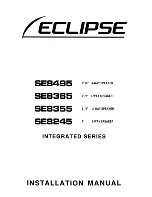
FINAL SOUND
100i
Loudspeaker Manual vs. 2.0 -US- c FS 2008 15
.
that, due to noise cancellation, the dipole panels do not radiate much sound to the sides. A dipole is
less influenced by room acoustics and sounds more like the original recording did. The line array
character also adds to the ‘less room interaction behaviour’. Usually, line arrays do not enforce floor
and ceiling reflexions.
What about the Inverter?
The Final electrostatic drivers are based on our patented Inverter technology. As most great ideas in
history, the underlying principles are basically simple. A traditional electrostatic driver will put the high
voltage to the membrane and the musical signal to the stators. In an Inverter based electrostatic driver,
this is vice versa. The main advantage is that we can separate the diaphragm in pre defined radiating
areas for high, mid and low frequencies. When you can size radiating areas, you can also size the
driver’s radiating patterns. That’s the main reason that our electrostatic loudspeakers do not have a
‘hotspot’. They present a wide stereo image from nearly every listening position in the room.
What happened to the loudspeaker’s enclosure?
There is an inherent relationship between dynamic drivers and enclosures. The enclosure’ s shape,
volume and size are important supporting parameters to accomplish a specified performance level
from dynamic systems. So between dynamic drivers and enclosures are almost mathematical
dependencies. Basically, a dynamic driver is designed to operate in an enclosure.
Electrostatic drivers don’t need enclosures. The only reason for finding enclosed electrostatic
loudspeakers has to do with electrical safety. Due to our patented Inverter technology, Final
electrostatic panels don’t need enclosures for electrical safety reasons. Getting rid of enclosures is
pretty cost effective and it translates into a reasonable consumer price. Since the speaker cabinet is
the most expensive part in most of the dynamic systems (woofers, tweeters, and crossovers are
usually less than 30% of the materials cost of a typical box speaker). Because there is no cabinet,
Final electrostatic loudspeakers do not have any cabinet induced coloration and sound very neutral.
How much power do you need?
The simplicity of the Final Inverter Technology enables the loudspeaker’s impedance to remain higher
than traditional electrostatic panels and we specify them as nominal 4 ohms (higher below 15Khz and
lower below). This allows the use of smaller amplifiers.
Although our loudspeakers will work fine with the majority of reasonably priced amplifiers from 50 W
Watt/channel and up, we also know that our panels will benefit when driven by high powered quality
amps. This knowledge is not limited to the use of electrostatic loudspeakers but is true for any
loudspeaker in the market. Exceptions are the high sensitive loudspeakers, which you can drive with
low powered triode and other tube amplifiers. But this belongs to the exclusive domain of audiophile
knowledge and the ultimate dedication towards sound quality. To complete this chapter; room size and
room acoustics have something to do with this equation as well. Bigger rooms need more power,
smaller rooms less. Rooms with lots of absorption from drapes and furniture need more power;
reflective rooms less.
How large are the panels? Is there a special model for a center channel?
The panels come in a range of sizes from 20” tall to 80” tall for front and rear channel use. The center
panels range from 21” to 48” and can only be used in a horizontal position. The center panel includes a
separate vertically aligned tweeter assembly that extends the vertical response of the center channel to
60 degrees off axis.
The Models 100i and 200i can be floor standing or wall mounted. The larger panels are designed
primarily as floor-standing loudspeakers but the 300i is also available in a wall mountable version. The
wall brackets and floor stand are optional for the 100i and 200i models. The panels are sized to match
the height of the most popular selling brands of plasma TV between 32” and 60” diagonal.
Where should I place my subwoofer?
Coloration, due to resonance, is strongest at bass frequencies between 20 and 200 Hertz. It’s much
easier to obtain high absorption at higher frequencies. So, the placement of a subwoofer is critical.






































